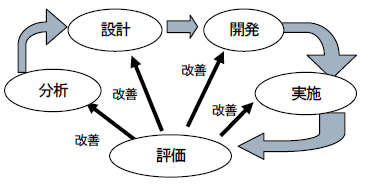The content here refers to "e-learning content," which is used in learning through the use of information and communication technology (ICT) and is the object of learning.
Now, needless to say, PlanDoSee (PDS) is the basis of systemic development. As a model for educational activities and content development methods, the ADDIE model, which proposed PDS according to the Instructional Design (ID) process, is probably the most famous [1]. The development of the project is a steady process of connection. However, it is also true that each process needs to be carried out steadily, and therefore a reasonable amount of time is required for development.
Research on Content Development Methods

ADDIE model (Suzuki (2005) Fig.1)
In recent years, Rapid Prototyping, which has been used in software development, has been widely adopted in content development where time is becoming a top priority, such as the three-step approach method by Allen [2]. Prototyping is the same as the ADDIE model of the five processes. The difference between the former method of steadily proceeding with each of the five processes and the latter method of conducting DDEs on an occasional basis and repeating them several times is that the time is reduced while maintaining the level of completion.

3段階連続接近法:Allenモデル (Suzuki (2005) Fig.2)
In recent years, object-oriented development has become more and more common in the field of content development, just as it is in the field of software development. The advantage of this approach is that we can develop and modify objects by defining units (things) that perform certain behaviors (data and methods) and have relationships with other objects (properties), and then combining them in a flexible way. Representations of Learning Objects (LOs) include IEEE's Learning Object Metadata (LOM) and SCO in the Sharable Content Object Reference Model (SCORM) [3].
The spread of the e-learning 2.0 concept with the development of Web 2.0 and related ICT will promote the trend of content mash-up [4]. In the e-learning 2.0 era, where pull-type learning by learners themselves is the main focus and content mashups are promoted, the sharing of quality-assured content, or LOs, is expected to become even more important in the future.
Required reading
[a] Katsuaki Suzuki(2005)Instructional Design for e-Learning Practices , Japan Society for Educational Technology Journal 29(3), 197-205.(in Japanese)(http://www.gsis.kumamoto-u.ac.jp/ksuzuki/resume/journals/2005b.pdf)
[b] Wave of e-learning 2.0 (1), The State of E-Learning Abroad (Part 16) (in Japanese) http://203.183.1.152/kyoutsu/kaigai/n_kaigai_lp16.htm
References
[1]
- Introduction to Instructional Design
http://itle.okstate.edu/fd/online_teaching/intro_to_id.html - ADDIE Model,
Learning-Theories.com
http://www.learning-theories.com/addie-model.html
[2]
- Allen, M. W., (2003), Designing Successful e-Learning: Forget What You Know About Instructional Design and Do Something Interesting, Pfeiffer & Company
- Allen, M. W., (2006), Creating Successful e-Learning: A Rapid System for Getting It Right First Time, Every Time, Pfeiffer & Company
- Rapid Prototyeping, Wikipedia, http://en.wikipedia.org/wiki/Rapid_prototyping
[3]
- Getting Object-Oriented Right(in Japanese)
http://itpro.nikkeibp.co.jp/article/COLUMN/20060921/248617/ - You can always understand Object-Orientation in 5 minutes.(in Japanese)
http://www.atmarkit.co.jp/im/carc/special/fiveoo/00.html - Holzinger, A., Smolle, J., & Reibnegger, G., (2005), Learning Objects(LO): an Object-Oriented Approach to Manage e-Learning Content, Encyclopedia of Informatics in Healthcare & Biomedicine, pp.89-98, Lazakidou, A. Ed., Hershey, PA, ( http://user.meduni-graz.at/andreas.holzinger/holzinger/papers%20en/E06%20Learning%20Objects.pdf )
- IEEE LOM, IEEE Learning Technology Standards Committee, http://ltsc.ieee.org/wg12/
[4]
- Web 2.0-style tools are transforming the university's educational landscape(in Japanese), CNET Japan, http://japan.cnet.com/special/media/story/0,2000056936,20354034,00.htm